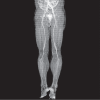Systemic capillary leak syndrome induced by influenza type A infection
- PMID: 27752564
- PMCID: PMC5052828
- DOI: 10.15441/ceem.14.028
Systemic capillary leak syndrome induced by influenza type A infection
Abstract
A 42-year-old man visited the emergency department complaining of lower extremity swelling and myalgia. His influenza A antigen test was positive, and he was admitted for supportive care of severe myalgia. On the first hospital day, the swelling in his lower legs was aggravated with intolerable pain, and his creatine phosphokinase and hemoglobin levels were elevated. He was treated with massive hydration, albumin replacement, continuous venovenous hemofiltration, phlebotomy, and oseltamivir. The swelling and pain in his extremities were decreased without renal dysfunction, even though peripheral neuropathy and muscular complication persisted. Systemic capillary leak syndrome is a rare but life-threatening condition. The diagnosis is made clinically based on a classic triad of hypotension, hypoalbuminemia, and hemoconcentration. In our case, the influenza A infection was related to the capillary leakage.
Keywords: Capillary leak syndrome; Edema; Hypoalbuminemia; Influenza A virus; Rhabdomyolysis.
Conflict of interest statement
No potential conflict of interest relevant to this article was reported.
Figures


Similar articles
-
Capillary Leak Syndrome Aggravated by Influenza Type A Infection.Cureus. 2018 Apr 30;10(4):e2554. doi: 10.7759/cureus.2554. Cureus. 2018. PMID: 29974010 Free PMC article.
-
Clinical and pathological findings of a fatal systemic capillary leak syndrome (Clarkson disease): a case report.Medicine (Baltimore). 2015 Mar;94(9):e591. doi: 10.1097/MD.0000000000000591. Medicine (Baltimore). 2015. PMID: 25738482 Free PMC article.
-
Systemic capillary leak syndrome associated with a rare abdominal and four-limb compartment syndrome: a case report.J Med Case Rep. 2014 Jun 16;8:196. doi: 10.1186/1752-1947-8-196. J Med Case Rep. 2014. PMID: 24934689 Free PMC article.
-
[Idiopathic systemic capillary leak syndrome (Clarkson disease) : A rare cause of recurrent life-threatening edema].Internist (Berl). 2018 Jul;59(7):725-735. doi: 10.1007/s00108-018-0409-2. Internist (Berl). 2018. PMID: 29619573 Review. German.
-
[Systemic capillary leak syndrome causes a compartment syndrome of both lower legs and a forearm. A case report with a review of the literature].Unfallchirurg. 2005 Sep;108(9):770, 772-5. doi: 10.1007/s00113-005-0918-z. Unfallchirurg. 2005. PMID: 15778826 Review. German.
Cited by
-
Fluid balance concepts in medicine: Principles and practice.World J Nephrol. 2018 Jan 6;7(1):1-28. doi: 10.5527/wjn.v7.i1.1. World J Nephrol. 2018. PMID: 29359117 Free PMC article. Review.
References
-
- Dworschak AM, Wiebe B, Pohlmann U, Ehlen M, Scholer-Everts R, Bartmann P. Influenza A-associated rhabdomyolysis with acute renal failure. Klin Padiatr. 2008;220:266–7. - PubMed
-
- Unverdi S, Akay H, Ceri M, et al. Acute kidney injury due to rhabdomyolysis in H1N1 influenza infection. Ren Fail. 2011;33:450–1. - PubMed
-
- Frohlich G, Grawe A, Schmidt N, Roth R, Marker-Hermann E. Difficult course of rhabdomyolysis in influenza A/H1N1. Dtsch Med Wochenschr. 2013;138:2351–4. - PubMed
-
- Matsumura M, Kakuchi Y, Hamano R, et al. Systemic capillary leak syndrome associated with compartment syndrome. Intern Med. 2007;46:1585–7. - PubMed
-
- Dhir V, Arya V, Malav IC, Suryanarayanan BS, Gupta R, Dey AB. Idiopathic systemic capillary leak syndrome (SCLS): case report and systematic review of cases reported in the last 16 years. Intern Med. 2007;46:899–904. - PubMed
LinkOut - more resources
Full Text Sources
Other Literature Sources

